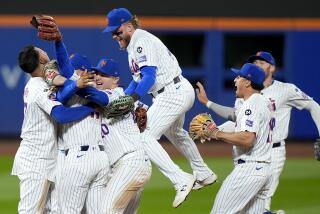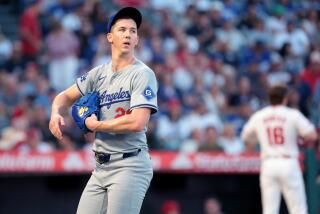Templeton Has Made a Big Switch
- Share via
It is an axiom in baseball that hitters are born, not made.
Except switch-hitters. They are as fabricated as aluminum siding. No one comes out of the womb with equal ability to hit the ball from both sides of the plate. It is what the geneticists call an acquired characteristic.
For proof, ask yourself how many people can throw from both sides of their bodies?
A switch-hitter is an impostor from one side of the plate. He has conditioned himself to do something unnatural. It is like a bear roller-skating. You are not only surprised it is done well, you are surprised it can be done at all.
The greatest switch-hitter of all the ages of the grand game is certifiably Peter Edward Rose. Pete has more than 3,000 hits left-handed and 1,100 right-handed. Pete is, of course, by definition, the most prolific hitter in the history of the game.
Switch-hitters are, ordinarily, banjoists by trade. Often, they are so ineffective batting the way God intended that that is precisely why management turns them around. They usually have nothing to lose.
Maury Wills languished in the minor leagues nine years as a right-hander until Bobby Bragan suggested that he might as well miss the ball left-handed, too. Instead, Maury became a Hall of Fame ballplayer--in my book, at least--and the Dodgers became chronic pennant winners.
Not all switchers are slap-and-run. In addition to Pete Rose who, after all, has hit 160 home runs in a career where he was only trying to make singles, there was Mickey Mantle. Mickey slugged 536 home runs, 373 of them left-handed and 163 right. It was not that Mantle was stronger one way. Switch-hitters just naturally face more right- handed pitching.
Mickey also topped all switch-hitters for average in a single season. He hit .365 in 1957.
Frankie Frisch probably has the highest lifetime average of any switch-hitter, .316, unless the Cardinals’ Willie McGee puts together another .353 season this year.
Lots of switch-hitters got 200 hits a season. Pete Rose did it 10 times. Frisch did it three. Mantle never did it.
But only two switch-hitters have ever had 100 or more hits from each side of the plate.
Garry Templeton was the first when, in 1979, he collected 111 hits left-handed and 100 right. Willie Wilson became the second--and the first American Leaguer--to do it when he got 130 hits left-handed and 100 right the next season.
If the San Diego Padres win the National League West championship this year--and that might be the way to bet--it may be because Garry Templeton is the best two-way ballplayer, day-in, day-out, in the league today.
When the Padres acquired Templeton for Ozzie Smith in 1982, it was widely believed that the Padres were trading away the most dazzling shortstop in the long history of the game for a practicing malcontent--Mr. Shortstop for Mr. Shut Up! The Wizard of Oz for the Wizard of Oops!
The prevailing opinion was, the Padres had traded for a headache, maneuvered for disruption.
A funny thing happened to Garry Templeton in San Diego. Nothing.
The man who had aroused the ire of St. Louis fandom, who had testily announced that he would not attend an All-Star game unless assured of starting, the man whose manager, Whitey Herzog, he had assaulted in a rage in the dugout, disappeared in a San Diego uniform and was replaced by Mr. Nice Guy.
The man they called Garry Tempertantrum in St. Louis became Garry Temperate in San Diego. Mr. Hyde went back into the test tube.
“I let things get out of hand in St. Louis,” Templeton said as he sat in a locker room at Dodger Stadium the other night. “It was a lot of things, but basically I put some pressure on myself that didn’t need to be there. I have removed it.”
He bears no animus toward Herzog. “I told Whitey I wanted to be traded to the West Coast, to the Dodgers or the Padres,” he said, “and he said he would do it if he could and he was as good as his word. I appreciated that.”
Garry Lewis Templeton, in the view of most scouts who saw him, was an almost perfect ballplayer when he first came out of Santa Ana Valley High School.
He was swift--he stole 28 bases his first full season in the big leagues and 34 his second. He could hit--.322 his first full season and over .300 in three of his first four seasons. He could go into the hole for the ground ball better than anyone in the game. There really wasn’t much he couldn’t do with a ball, a glove or a base to steal.
The word was, he was too good to be true. Missed planes, skipped meetings, fights with the manager or teammates were freely predicted. But in San Diego, Templeton became a company man in the image of Steve Garvey. He was as dependable as a butler.
As a result, the Padres found themselves very quickly in an unaccustomed surrounding--the World Series. It wasn’t Templeton’s fault they lost it. He hit .316. It was partly his fault they were in it--he hit .333 in the playoffs.
It was bad knees, not bad attitude, that began to plague Garry Templeton. But neither one could keep him out of the lineup. Tempy, as they called him, didn’t keep himself contentious but the Padres in contention.
He excelled in another category not normally associated with shortstops: intentional walks. Historically, pitchers walk the Babe Ruths, the Henry Aarons, the guys who, with one swing, can put you out of a ball game.
One time last year, Garry Templeton tied a major league record set by Roger Maris, no less. He was walked intentionally four times in one game. He was walked 25 times on purpose all season, tying for the league lead, and it was the second straight season Templeton had led the league.
Templeton characteristically downplays the tribute pitchers pay to him by putting him on in dangerous situations. “I was batting eighth and with the pitcher coming up I was eligible for a walk,” he said, shrugging.
Teammate Garvey disagrees. “Tempy might get a walk as a lead-off man,” he said. “It’s for sure no one wants to pitch to him with men on base at any time.”
Garry Templeton is off to a typical slow start this season. So, not-so-coincidentally, are the Padres.
Last season, he started off with a .183 average for the first month but wound up with the highest batting average any San Diego shortstop ever had. He came into Dodger Stadium the other night hitting .229, but he had been hitting at a .346 clip for his last 14 games.
The Padres are not worried. Not when you have a player as steady, conscientious and dependable as No. 1 on their program.
Now that Tempy no longer is short for Temperamental, they can go ahead and plan for another playoff with a rock-steady guy like that in the infield.
More to Read
Go beyond the scoreboard
Get the latest on L.A.'s teams in the daily Sports Report newsletter.
You may occasionally receive promotional content from the Los Angeles Times.










